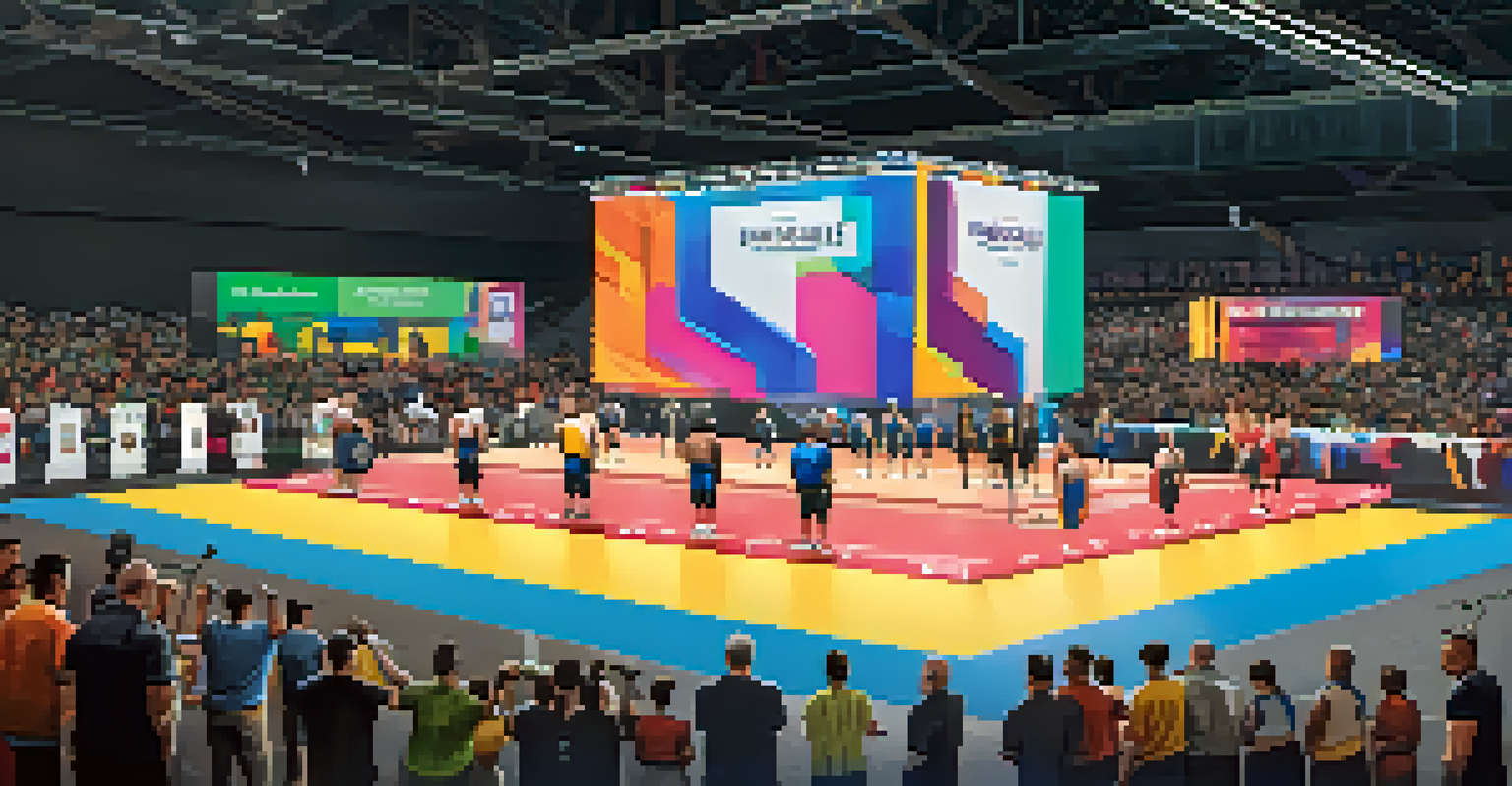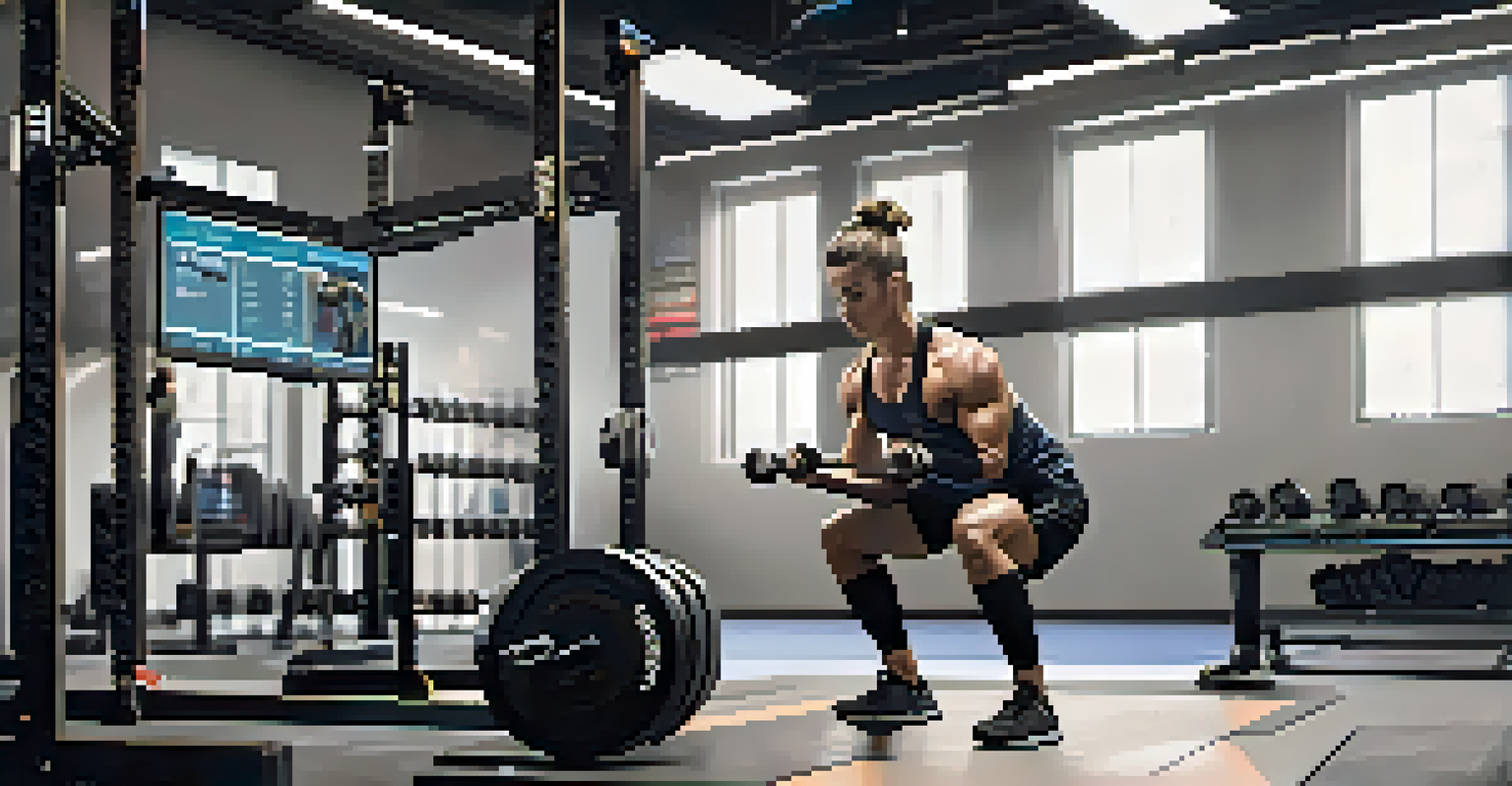The Evolution of Powerlifting Techniques Over Decades

The Origins of Powerlifting Techniques in the 1960s
Powerlifting, as we know it today, began taking shape in the 1960s, evolving from older forms of strength competitions. During this time, athletes focused on three primary lifts: the squat, bench press, and deadlift. The techniques were straightforward, often relying on raw strength rather than refined methods. Lifters experimented with various stances and grips, laying the groundwork for more structured approaches in subsequent decades.
Strength does not come from physical capacity. It comes from an indomitable will.
In this era, training was often informal, with many lifters learning from one another rather than through organized programs or coaches. The lack of resources meant that lifters relied heavily on trial and error to find what worked best for them. This grassroots approach fostered a sense of community among early powerlifters, as they shared tips and techniques in gyms across the country.
As the sport gained popularity, the need for standardized techniques emerged. This shift would eventually lead to more systematic training methodologies, paving the way for the evolution of powerlifting techniques we see today. The 1960s marked the beginning of a journey that would see powerlifting grow into a refined and respected competitive sport.
Refinement of Techniques in the 1970s
The 1970s were a pivotal decade for powerlifting, as lifters began to refine their techniques significantly. With the introduction of more formal competitions, athletes started to focus on form and technique, understanding that precision could lead to better lifts. The importance of proper mechanics became evident, as lifters began to study their lifts more closely, often filming themselves to identify areas of improvement.

As powerlifting organizations emerged, standardized rules and regulations also helped shape training techniques. The establishment of federations meant lifters had to adhere to specific lifting styles and equipment regulations, prompting them to adapt their techniques accordingly. This period saw the rise of specialized training programs tailored to enhance performance in each of the three main lifts.
Powerlifting's Evolution Over Decades
Powerlifting has transformed from informal grassroots techniques in the 1960s to a sophisticated sport shaped by technology, science, and specialization.
Moreover, influential figures in the sport, such as world champions and coaches, began to share their knowledge through seminars and publications. This sharing of information facilitated the spread of effective training techniques, allowing lifters from different backgrounds to learn and improve. The 1970s truly set the stage for a more scientific approach to powerlifting.
The Rise of Technology in the 1980s
The 1980s ushered in a new era of powerlifting with the advent of technology, changing how athletes trained and competed. Equipment like powerlifting belts, knee wraps, and specialized shoes became more widely used, providing lifters with additional support and enhancing their performance. This increase in technology led to a greater emphasis on lifting heavier weights, as athletes pushed the boundaries of what was possible.
The only way to prove that you are a good sport is to lose.
With the rise of video technology, lifters could analyze their performances in real-time, leading to more tailored training strategies. Coaches began to use video analysis to refine techniques, helping athletes correct form issues and optimize their lifts. This technological advancement allowed for a more personalized training experience, which contributed to better outcomes in competitions.
As powerlifting gained visibility, numerous competitions were broadcasted, inspiring a new generation of lifters. This exposure further fueled interest in the sport and encouraged more individuals to explore powerlifting techniques. The 1980s marked a turning point, as lifters began to realize the impact of technology on their performance and training.
The Influence of Science and Research in the 1990s
The 1990s saw a significant shift in powerlifting as athletes and coaches began to embrace scientific research and data-driven training. This decade was marked by an influx of studies on strength training, biomechanics, and nutrition, which provided valuable insights for lifters. As a result, training programs became increasingly sophisticated, focusing on optimizing performance through evidence-based methods.
Lifters began to understand the importance of recovery and periodization, with many adopting structured training cycles that focused on varying intensity and volume. This approach allowed athletes to peak at the right time for competitions, improving their chances of success. Coaches took on a more prominent role, often becoming the driving force behind an athlete's development and performance.
Community Impact Through Social Media
The rise of social media in the 2010s has fostered a sense of community among lifters, facilitating technique sharing and support across diverse backgrounds.
Additionally, the 1990s brought about a greater awareness of the mental aspects of lifting. Sports psychology began to play a role in training, with athletes utilizing techniques to enhance focus and reduce competition anxiety. This holistic approach to powerlifting set the stage for the continued evolution of techniques in the years to come.
The Emergence of Specialization in the 2000s
As powerlifting continued to evolve into the 2000s, specialization became a prominent theme. Athletes began to focus on specific lifts, with many choosing to compete in only one or two of the primary events. This shift enabled lifters to hone their techniques further, allowing for unprecedented improvements in performance. Specialized training programs emerged, catering to the unique demands of each lift.
With more lifters embracing specialization, the competition landscape changed dramatically. Records were continually broken as athletes focused their training on mastering their chosen lifts. The rise of specific coaching styles also emerged, with trainers offering tailored programs that reflected the individual strengths and weaknesses of each athlete.
Moreover, the popularity of powerlifting increased, leading to greater participation in competitions and the rise of social media. Lifters began sharing their journeys online, creating communities that encouraged knowledge sharing and support. This interconnectedness helped to further refine powerlifting techniques, as lifters learned from one another's experiences and insights.
The Role of Social Media in Technique Sharing (2010s)
The 2010s marked a significant turning point for powerlifting, as social media platforms became the go-to source for technique sharing and community building. Athletes began posting their training sessions, sharing insights, and providing tips to their followers. This democratization of information allowed for a rapid exchange of ideas and techniques, benefiting newcomers and seasoned lifters alike.
Online platforms also spurred the rise of virtual coaching, where lifters could receive personalized guidance from experienced coaches regardless of geographical barriers. This accessibility led to an explosion of diverse training methodologies, as lifters explored different styles and approaches from around the world. As a result, many athletes were able to find techniques that resonated with them, leading to improved performance.
Data-Driven Training Today
Modern powerlifters leverage technology and data analytics to optimize their training and performance, making the sport more accessible and inclusive.
Furthermore, social media facilitated the growth of powerlifting challenges and trends, creating a sense of camaraderie among lifters. Hashtags like #Powerlifting and #SquatGoals became popular, encouraging athletes to share their progress and celebrate their achievements. This sense of community helped to keep lifters motivated and engaged, further enhancing the evolution of powerlifting techniques.
Current Trends and Future of Powerlifting Techniques
Today, powerlifting techniques continue to evolve, shaped by a blend of tradition and innovation. Athletes are now more data-driven than ever, utilizing technology like wearable devices and performance tracking apps to monitor their progress. This focus on data allows for real-time adjustments in training, optimizing performance while minimizing the risk of injury.
Moreover, there's an increasing emphasis on inclusivity in the sport, with more diverse athletes competing at various levels. This shift has led to the emergence of new training techniques that cater to different body types and abilities, making powerlifting accessible to a broader audience. As more individuals embrace the sport, the techniques used will likely continue to adapt and evolve to accommodate these changes.

Looking to the future, it’s exciting to consider what lies ahead for powerlifting techniques. With ongoing advancements in sports science and technology, lifters will have even more resources at their disposal. Whether it's through innovative training methods or the continued sharing of knowledge within the community, the evolution of powerlifting techniques is sure to keep pushing the boundaries of what athletes can achieve.